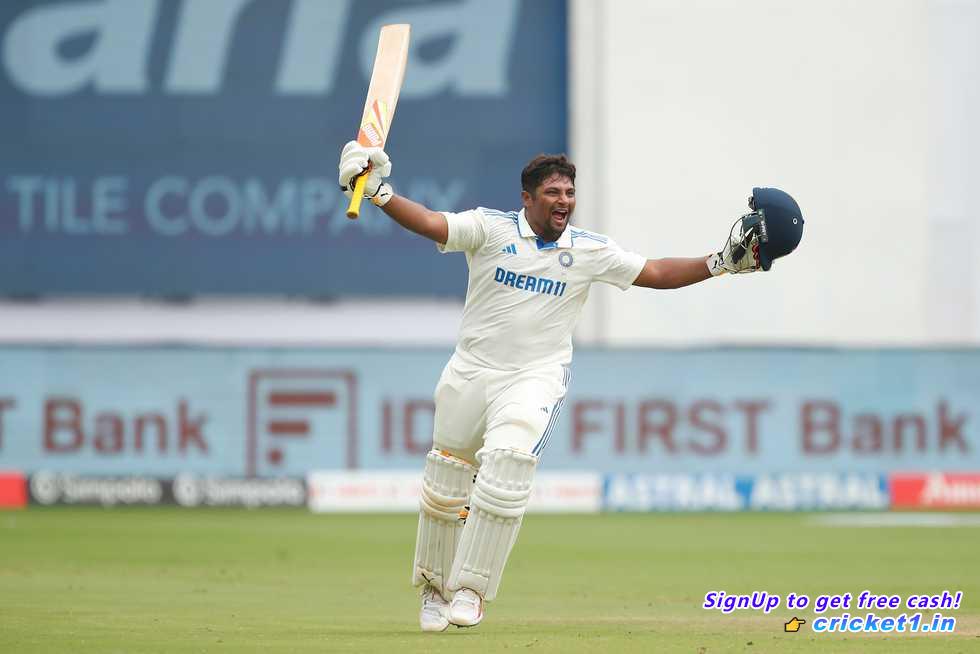
Sarfaraz Khan etched his name in cricket’s annals with a stunning display during his first Test century. The match saw the talented batsman carry India from a daunting deficit of 251 to a commendable lead of 52, thanks to his resolute 150-run innings. The first innings duck, a forgotten inconvenience, was overshadowed by Sarfaraz’s prodigious display of skill and determination during the second outing. A crucial partnership with Rishabh Pant, amassing 177 runs, added to the thrilling narrative, peppered with moments that swiftly turned into viral sensations across cricketing circles.
One of the more memorable highlights from the inning was the lively hundred celebrations that left the dressing room in stitches, coupled with a comical scene where Sarfaraz frantically leaped to halt Pant from attempting a double run. This charming scene unfolded when Sarfaraz, momentarily forgetting Pant’s injury, panicked mid-run, eventually resorting to a medley of animated signals to avert any potential harm. Luckily, none was inflicted.
Merely over a month ago, at the very same ground, the pair had exhibited a similar synergy in a 72-run stand from 55 balls. They faced an intimidating opposition comprising talents like Akash Deep and Kuldeep Yadav, contextualizing Pant’s return to red-ball cricket. Reflecting a similar scenario, the duo’s electric counterattack strategy secured a victory, echoing past strategies that inevitably influenced their approach in this current game.
While crafting a masterful inning of 41 earlier, Sarfaraz rattled Akash Deep by dispatching five successive boundaries at one point. Particularly instrumental was his precise dab past gully, infusing a leitmotif that resonated throughout his Test hundred—a stroke likely to become entrenched in cricket lore as a Sarfaraz-ian signature move.
Although Sarfaraz had employed this technique previously in Test cricket, he had never executed it with such regularity or success. An astonishing 58 of his 92 Test runs scored behind square on the offside originated from this singular innings alone, showcasing an array of shots executed with finesse and precision. These included standing still to bunt length balls, arching back to deftly ramp over the wicket-keeper, and daring upper-cuts that covered varying angles. His shots would sometimes whiz past gully or streak wide of the third man, daunting both pacers and spinners, irrespective of their setups. Even with a slip in place, Sarfaraz audaciously maneuvered his hands, maintaining a controlled expression of dominance. Upon reaching his century, Sarfaraz had accrued 44 runs from the third-man region alone, notwithstanding any direct drive along the ground.
New Zealand’s tactical approach presupposed that targeting a short batsman on a bouncy wicket would yield success; however, their efforts were thwarted as Sarfaraz not only confronted the strategy but thrived against it. His prowess rendered their ploy ineffective, compelling Will O’Rourke, who secured seven wickets throughout the match, to commend, “I think he probably played me really well..
.. With that angle of me sort of falling away, it sort of opens up that little dab shot… I would have liked to be a little bit tighter. Obviously, one of his strengths is that.”
Sarfaraz’s batting style is a testament to home-grown tactics, largely instructed by his father, Naushad Khan, fondly known as the “family doctor.” Naushad ensured Sarfaraz was well-equipped by installing floodlit facilities at home, permitting Sarfaraz to hone his craft. Though unorthodox, this method has proved effective, promising entertainment and formidable results, confirmed by Kuldeep Yadav with a grin as he stated, “everyone enjoys in the dressing room.” Sarfaraz, reveling in the moment, shared, “It was fun… I have a bouncy wicket back at home (Mumbai), and I play regularly there, and the bounce easily allows me to cut it.”
Despite Sarfaraz’s monumental achievement, India concluded the day with unfinished business. Setting New Zealand a target of 107 runs had them in an advantageous position, but Sarfaraz was unfazed by the looming challenge. “It isn’t an easy wicket to bat on, and I don’t think the game is out of our hands yet… If we manage to get two to three wickets of theirs early on, even they could be in a similar situation,” Sarfaraz confidently stated. Heading into the final day, the spirit of determination after Sarfaraz’s innings imbued fresh hope within the team, igniting aspirations of a possible comeback in the contest.

